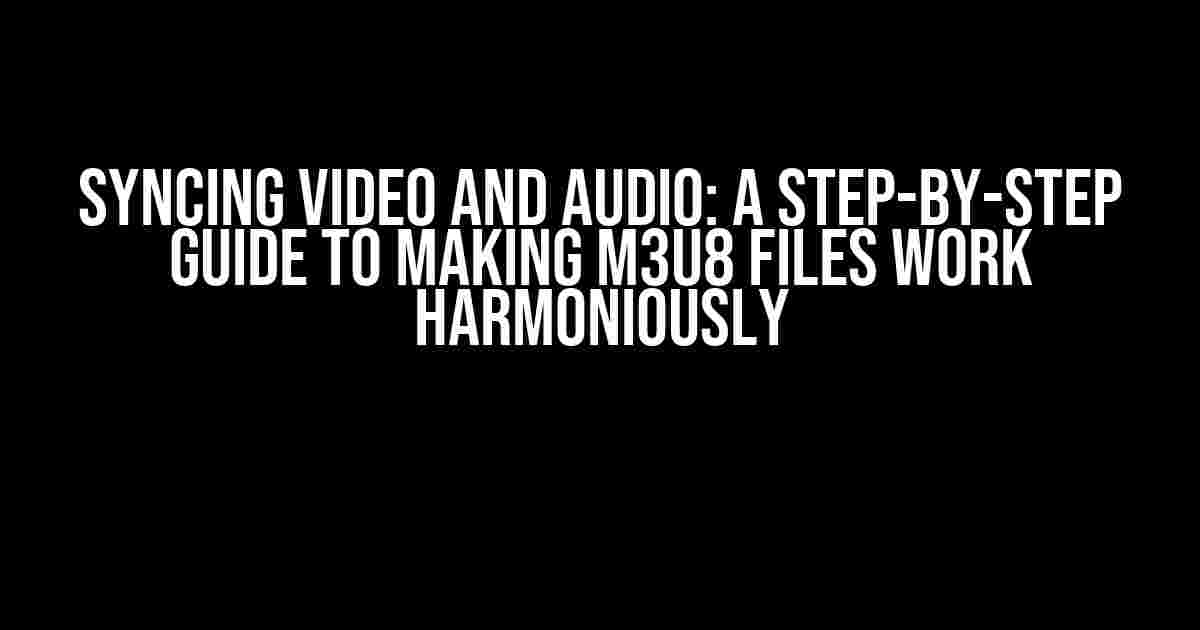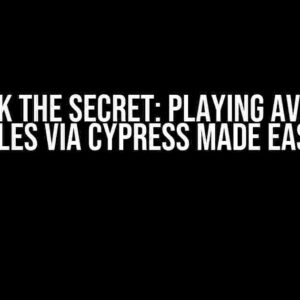Are you tired of dealing with M3U8 files that just won’t sync video and audio playback? You’re not alone! Many of us have struggled with this issue, but fear not, dear reader, for today we’re going to dive into the world of M3U8 files and explore the secrets of making both video and audio play at the same time.
What is an M3U8 file, anyway?
Briefly, an M3U8 file is a type of playlist file used to stream audio and video content, particularly for Apple devices. It’s essentially a text file that contains a list of URLs pointing to the actual media files. But, unlike a traditional playlist, M3U8 files can contain metadata, such as timestamps and durations, which makes them more versatile.
The Problem: Video and Audio Out of Sync
So, why do video and audio often fall out of sync in M3U8 files? The main reason is that the audio and video streams are encoded and stored separately, which can lead to desynchronization issues. Add to that the complexity of modern media players and devices, and you’ve got a recipe for disaster.
The Solution: A Step-by-Step Guide
Enough chit-chat! Let’s get down to business. Here’s a step-by-step guide to making both video and audio play at the same time in an M3U8 file:
Step 1: Prepare Your Tools
To get started, you’ll need the following:
- A text editor (e.g., Notepad++, Sublime Text, or Atom)
- A media converter or encoder (e.g., FFmpeg, HandBrake, or Adobe Media Encoder)
- A compatible media player (e.g., VLC, Kodi, or Apple’s built-in player)
Step 2: Encode Your Video and Audio Files
Using your chosen media converter or encoder, encode your video and audio files separately. Make sure to use the same codec and settings for both files to ensure compatibility. For example, you can use the H.264 codec for video and AAC for audio.
# For video encoding:
ffmpeg -i input.mp4 -c:v libx264 -crf 18 output.h264
# For audio encoding:
ffmpeg -i input.mp3 -c:a aac -b:a 128k output.aac
Step 3: Create an M3U8 File
Using your text editor, create a new file and save it with an .m3u8 extension. Add the following lines to the file:
#EXTM3U
#EXT-X-VERSION:3
#EXT-X-TARGETDURATION:10
#EXT-X-MEDIA-SEQUENCE:0
The `#EXTM3U` line indicates that this is an M3U8 file. The `#EXT-X-VERSION` line specifies the version of the M3U8 protocol. The `#EXT-X-TARGETDURATION` line sets the target duration of each segment, and the `#EXT-X-MEDIA-SEQUENCE` line sets the sequence number of the media files.
Step 4: Add Video and Audio Segments
Next, add the video and audio segments to the M3U8 file. Use the following format:
#EXTINF:10.0,
output.h264
#EXT-X-DISCONTINUITY
#EXTINF:10.0,
output.aac
The `#EXTINF` line specifies the duration of the segment, and the filename points to the actual media file.
Step 5: Add Timestamps and End Tags
Add timestamps to the video and audio segments using the `#EXT-X-PROGRAM-DATE-TIME` line:
#EXT-X-PROGRAM-DATE-TIME:2022-01-01T12:00:00Z
#EXTINF:10.0,
output.h264
#EXT-X-PROGRAM-DATE-TIME:2022-01-01T12:00:00Z
#EXT-X-DISCONTINUITY
#EXTINF:10.0,
output.aac
Finally, add the end tag `#EXT-X-ENDLIST` to indicate the end of the playlist:
#EXT-X-ENDLIST
Step 6: Test Your M3U8 File
Save your M3U8 file and test it in your chosen media player. Make sure to enable the “Sync” or “Synchronize” option in the player settings to ensure that the video and audio play back in sync.
Troubleshooting Common Issues
Even with these steps, you might still encounter some issues. Here are some common problems and their solutions:
Issue 1: Video and Audio Out of Sync
If your video and audio are still out of sync, try adjusting the timestamp values in the M3U8 file. You can use tools like FFmpeg to extract the timestamp information from the media files.
Issue 2: M3U8 File Not Playing
If your M3U8 file isn’t playing at all, check the file paths and names to ensure they’re correct. Also, make sure that the media player is compatible with M3U8 files.
Issue 3: Audio Not Playing
If the audio isn’t playing, check the audio encoding settings and ensure that they match the video encoding settings.
Conclusion
Making both video and audio play at the same time in an M3U8 file requires some effort, but with these steps, you should be able to achieve sync heaven! Remember to double-check your encoding settings, timestamp values, and file paths to avoid common issues. Happy streaming!
| Tool | Description |
|---|---|
| FFmpeg | A free, open-source media converter and encoder |
| HandBrake | A free, open-source video transcoder |
| Adobe Media Encoder | A commercial media encoder and converter |
| VLC | A free, open-source media player |
| Kodi | A free, open-source media player and entertainment hub |
Remember, practice makes perfect, so don’t be afraid to experiment and try different approaches until you get the desired result.
FAQs
Q: Can I use an M3U8 file with multiple audio tracks?
A: Yes, you can use an M3U8 file with multiple audio tracks. Simply add separate audio segments for each track and specify the language or other metadata using the `#EXT-X-MEDIA` tag.
Q: How do I add subtitles to an M3U8 file?
A: You can add subtitles to an M3U8 file by using the `#EXT-X-SUBTITLE` tag and specifying the subtitle file path and language.
Q: Can I use an M3U8 file with live streaming?
A: Yes, you can use an M3U8 file with live streaming by using the `#EXT-X-ENDLIST` tag to indicate the end of the live stream.
That’s it! With these tips and tricks, you should be able to create an M3U8 file that plays both video and audio in perfect harmony. Happy streaming!
Frequently Asked Question
Have you ever struggled to play both video and audio simultaneously in an M3U8 file? Worry no more! Here are some common questions and answers to help you overcome this hurdle.
Q: What is the main reason why video and audio are not playing simultaneously in my M3U8 file?
A: The most common reason is that the audio and video streams are not properly synchronized or multiplexed in the M3U8 file. This can occur due to incorrect encoding or transcoding processes.
Q: Can I use FFmpeg to fix the synchronization issue and make both video and audio play at the same time?
A: Yes, you can use FFmpeg to multiplex the audio and video streams in your M3U8 file. You can use the -map option to specify the input streams and the -c option to copy the streams without re-encoding.
Q: What is the role of the EXT-X-MEDIA-TYPE attribute in the M3U8 file, and how can it affect the playback of video and audio?
A: The EXT-X-MEDIA-TYPE attribute specifies the type of media, such as VIDEO or AUDIO. If the attribute is not correctly set or is missing, it can cause issues with playback, including the audio and video not playing simultaneously.
Q: Can I use a media player like VLC to play the M3U8 file and fix the synchronization issue?
A: Yes, VLC media player can play M3U8 files and may be able to correct minor synchronization issues. However, if the issue is more complex, VLC may not be able to fix it, and you may need to use FFmpeg or other specialized tools to multiplex the streams.
Q: Are there any online tools or services that can help me fix the synchronization issue and make both video and audio play at the same time in my M3U8 file?
A: Yes, there are online services and tools, such as Mux, that can help you fix the synchronization issue and multiplex the audio and video streams in your M3U8 file. These services often provide a user-friendly interface and can be more convenient than using FFmpeg or other command-line tools.


